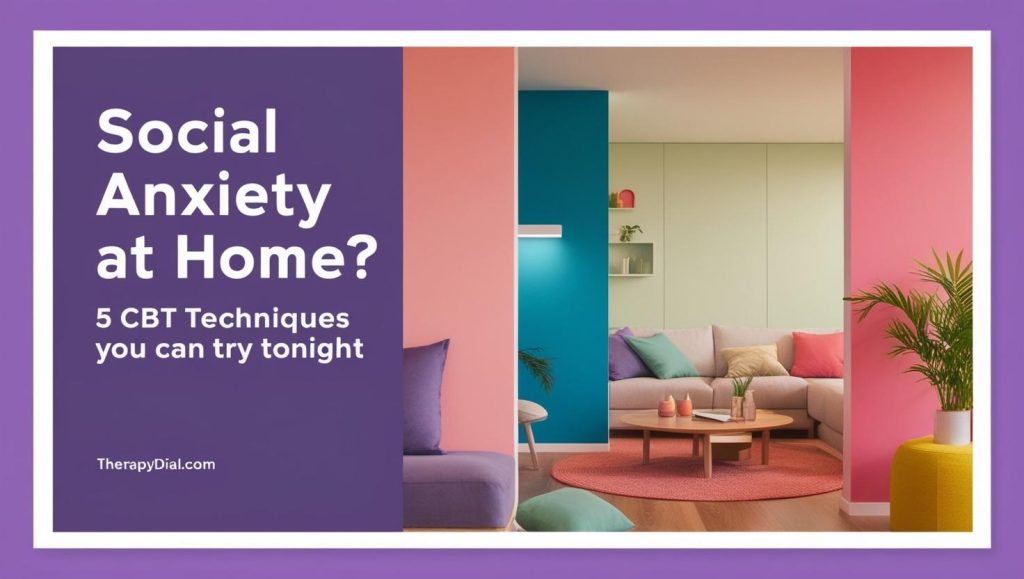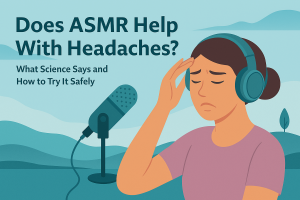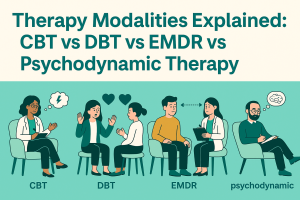Ever feel like your heart’s about to pound out of your chest when you’re just thinking about a social interaction—even if it’s just a Zoom call or texting someone back? That’s the grip of social anxiety. It’s more than just being shy.
It’s a deeply rooted fear of being judged, rejected, or embarrassed in front of others. And it doesn’t magically vanish when you’re at home.
In fact, for many people, home becomes a place of avoidance. You skip calls, avoid group chats, decline video invites—because your brain has trained you to think, “What if I say something stupid?” or “They’re going to think I’m awkward.” It’s like your mind becomes your biggest bully.
Why Cognitive Behavioral Therapy (CBT) Works
Now here’s the good news: Cognitive Behavioral Therapy is one of the most research-backed, effective ways to deal with social anxiety. Why? Because it doesn’t just tell you to “relax” or “get over it” (ugh, if only it were that simple).
CBT actually retrains your brain by helping you recognize, challenge, and change those unhelpful thoughts and behaviors.
CBT works because it’s structured, practical, and it teaches you to become your own therapist. It’s about changing your mental habits, not just reacting to anxiety when it pops up.
And guess what? You don’t always need a therapist to start benefiting. You can use CBT techniques right from your bedroom or couch.
The Power of Self-Guided CBT at Home
You don’t have to wait for an appointment or pay hundreds in therapy fees to start working on yourself. If you’re feeling stuck, overwhelmed, or even ashamed of your social fears—just know that there are tools, strategies, and exercises you can do tonight that actually help.
Whether it’s journaling your thoughts, doing a small exposure task (like sending that text you’ve been putting off), or learning to reframe a fear—these CBT techniques are accessible, empowering, and totally doable from home.
Ready to take your first step toward feeling more confident in social situations—even from your living room? Let’s get into the five CBT techniques that can help.
CBT Technique #1: Identifying Negative Thought Patterns
Understanding Automatic Negative Thoughts (ANTs)
Automatic Negative Thoughts—lovingly nicknamed “ANTs”—are those intrusive, often irrational thoughts that pop into your head without warning. Things like:
-
“I’m so awkward, no one wants to talk to me.”
-
“If I speak up, I’ll embarrass myself.”
-
“They’re definitely judging me right now.”
These thoughts don’t usually come from truth—they come from habitual mental programming. Over time, if you’ve experienced embarrassment, rejection, or criticism, your brain wires itself to expect those outcomes. So even in safe situations, you’re already bracing for disaster.
Real-Life Example of Thought Tracking
Imagine this: You get invited to a group video call with coworkers. Immediately, your mind says, “I’ll say something dumb. They’ll all laugh at me.” You cancel.
Here’s how CBT helps. Instead of just believing that thought, you write it down. Then you analyze it:
-
Is it 100% true?
-
What’s the evidence for and against it?
-
What might a friend say about this thought?
You begin to see your anxiety as something you experience, not something that defines you.
Tools You Can Use (Journals, Apps, Worksheets)
To identify these negative thought patterns, you can use:
-
A CBT thought diary (either on paper or with an app like MoodTools or CBT Thought Record Diary).
-
Journals where you log social situations, your reactions, and the thoughts that came with them.
-
Printable thought-tracking worksheets (Google “CBT thought record PDF” for free options).
Doing this regularly builds self-awareness, which is the foundation of change. Once you see the patterns, you can start breaking them.
CBT Technique #2: Thought Challenging and Reframing
How to Challenge Anxious Thoughts
Let’s say you’ve identified your thought: “Everyone will think I’m boring.” The next step? Challenge it.
This means asking yourself questions like:
-
What evidence do I have that this is true?
-
Have there been times when people actually enjoyed my company?
-
What’s the worst that could happen—and how bad would that really be?
When you shine a light on these thoughts, they lose their power. They go from facts to theories—and suddenly, you realize you don’t have to believe everything your mind says.
Reframing for a Healthier Mindset
Once you challenge the thought, it’s time to reframe it. Take that anxious narrative and flip it into something more balanced and realistic:
-
Instead of “They’ll think I’m boring,” try “I might not be the most exciting, but I have things worth saying.”
-
Replace “I’ll mess it up,” with “Even if I stumble, that doesn’t define me.”
This isn’t toxic positivity. It’s mental correction. You’re giving your brain a new way to interpret social situations—one that doesn’t lead straight to panic.
Thought Record Worksheet Exercise
Use a simple table like this to reframe anxious thoughts:
| Situation | Automatic Thought | Evidence For | Evidence Against | Balanced Thought |
|---|---|---|---|---|
| Joining a group chat | “I’ll say something dumb.” | I’ve fumbled words before. | But no one made fun of me, and I kept the convo going. | I might mess up, but I can still contribute meaningfully. |
Spend 10–15 minutes tonight filling out one of these. It might feel awkward at first, but it’s mental exercise—the more you do it, the stronger your confidence becomes.
CBT Technique #3: Exposure Practice at Home
The Science Behind Gradual Exposure
Let’s talk about one of the most powerful tools in the CBT toolkit: exposure. The idea is simple—but don’t confuse that with easy. Exposure therapy helps you slowly face the social situations that make you anxious. Instead of avoiding them, you take small, manageable steps toward confronting them.
Why does this work? Because when you avoid something over and over, your brain learns: “Yep, this is dangerous.” But when you face the fear (in small doses), you teach your brain the opposite: “Hey, this isn’t so bad after all.”
It’s like building muscle. You start with light weights and gradually add more. Same with anxiety—you face a small fear, survive it, and level up.
Creating an Exposure Ladder
Here’s a practical way to start: build an exposure ladder. It’s a list of situations ranked from least to most anxiety-inducing.
Example:
-
Sending a message in a group chat
-
Making a phone call to a friend
-
Joining a group video call
-
Attending an online meetup
-
Hosting a video call or leading a discussion
Start at the bottom. Pick the easiest one and do it—tonight, if you can. Repeat it until it feels easier, then climb to the next rung. This is how you gently desensitize your fear.
Keep a log of your experiences, how anxious you felt before/during/after, and what you learned. This helps reinforce the message that you’re in control—not your anxiety.
How to Practice Social Exposure in Safe Spaces
You don’t have to dive into public speaking or social events. Start at home, where it’s safer. Try these:
-
Voice message a friend instead of texting
-
Leave a comment on a social media post
-
Ask a question in an online group
-
Join a virtual game night or book club
The goal isn’t perfection—it’s progress. You’re building courage one small action at a time.
CBT Technique #4: Behavioral Activation
Breaking the Cycle of Avoidance
When social anxiety hits, avoidance becomes your default setting. You don’t RSVP, you cancel plans, you ghost people. It might give short-term relief, but long-term? It strengthens the fear.
This is where behavioral activation (BA) comes in. It’s about flipping the script—acting first, even when you don’t “feel” like it, and letting your emotions catch up later.
Think of it like starting a workout when you’re tired. You rarely feel motivated before—you just start, and the energy builds. BA helps you do the same with social situations.
Planning Positive Activities That Involve Social Contact
Start small. Choose activities that are both enjoyable and social, even if slightly uncomfortable.
Here’s a list of ideas:
-
Send a “thinking of you” text to someone
-
Share something in a group chat or forum
-
Set up a casual video call with one friend
-
Post a story or selfie to social media (if it feels doable)
-
Join a low-pressure online class or workshop
Don’t just hope these happen—schedule them. Treat them like appointments.
Using Scheduling and Rewards for Motivation
Create a weekly planner where you list 2–3 social micro-tasks. For each task, write:
-
What it is
-
When you’ll do it
-
How anxious you expect to feel (0–10)
-
A small reward for completing it
Maybe it’s a favorite snack, a movie night, or just a mental high-five. Rewards help reinforce positive action.
Example:
| Activity | Anxiety Rating | Completion Status | Reward |
|---|---|---|---|
| Comment in group chat | 4/10 | ✅ | Ice cream cone |
| Schedule Zoom with a friend | 6/10 | ✅ | 1 episode of favorite show |
When you take action, even with fear in the background, you’re proving to yourself: “I can do this.”
CBT Technique #5: Mindfulness and Relaxation Training
Calming the Nervous System
Social anxiety isn’t just mental—it’s physical. Your heart races, hands sweat, voice shakes. This is your body’s fight-or-flight system going haywire in social settings.
So how do you calm it down? Through mindfulness and relaxation techniques that regulate your nervous system and reduce anxiety on the spot.
Mindfulness trains you to stay in the present, rather than jumping into anxious predictions or overanalyzing the past. When you learn to observe your thoughts instead of drowning in them, you gain power over them.
Integrating Mindfulness Into Daily Routines
You don’t have to sit cross-legged on a mountain to practice mindfulness. Try these easy ways:
-
Mindful breathing: 4 seconds in, 6 seconds out. Do this for 2 minutes before a social situation.
-
Mindful walking: Focus on your steps, the feel of the ground, the rhythm of your pace.
-
Mindful listening: During a conversation, focus fully on the person’s words and tone, instead of what you’re going to say next.
Doing this daily—even for 5–10 minutes—trains your brain to respond to anxiety more calmly.
Guided Exercises for Immediate Relief
Try these free resources to practice relaxation tonight:
-
Headspace (free mindfulness meditations)
-
Insight Timer (huge library of anxiety-calming tracks)
-
YouTube Body Scan meditations
-
Progressive Muscle Relaxation (PMR) exercises (tense and release muscles one by one)
Before your next stressful call or social event, cue up a 5-minute grounding track. It might not erase the nerves—but it’ll help you stay centered, not spiral.
Building Your CBT Routine at Home
Creating a Weekly Plan
With all these techniques in your toolkit, the next step is to build a simple weekly CBT plan. Here’s how:
-
Choose 2–3 techniques to focus on each week.
-
Pick specific days and times to do them.
-
Track what worked and what felt hard.
Example weekly plan:
| Day | Task | Technique |
|---|---|---|
| Monday | Log negative thoughts | Thought Identification |
| Wednesday | Reframe one anxious thought | Thought Challenging |
| Friday | Send a message in group chat | Exposure |
| Daily | 5 min breathing meditation | Mindfulness |
Keep it realistic. You don’t need to fix everything overnight. This is about building mental fitness, one day at a time.
Tracking Progress and Adapting Techniques
Use a notebook, app, or Google Sheet to track your mood and success rates. Ask yourself:
-
What helped me feel more confident?
-
What triggered my anxiety most?
-
What should I try differently next week?
Adapt as needed. You’re not failing if one technique doesn’t work. You’re experimenting. That’s part of healing.
Knowing When to Seek Professional Support
If your anxiety is intense, paralyzing, or tied to trauma, self-help might not be enough. And that’s okay. CBT works even better with professional guidance.
You can find therapists via:
-
Open Path Collective (affordable therapy options)
There’s no shame in asking for help. CBT is powerful—but you are the one making the change. And that takes guts.
Conclusion
Let’s be real—social anxiety sucks. It can feel like a heavy weight pressing on your chest every time your phone rings or a message notification pops up. And while it might feel like you’re stuck with it forever, that’s simply not true.
You now have a toolkit filled with CBT techniques that are not only research-backed but completely doable from your own home.
From tracking your thoughts and reframing negative beliefs, to gradually exposing yourself to small social situations, each technique empowers you to challenge anxiety—not by force, but by compassionate action.
You’re not trying to “fix” yourself. You’re learning how to manage your mind, regulate your reactions, and show up in social spaces with confidence and calm.
The journey is gradual. Some days will feel easier than others. But if you keep showing up—even when it’s hard—you’ll begin to see real changes. Your thoughts will shift. Your fear will lessen. Your world will open up.
So tonight, take one small step. Pick one technique from this list, give it 10-15 minutes, and just try. You don’t have to do it perfectly. You just have to start.
And remember—you’re not alone in this. So many people are quietly fighting the same inner battles. With tools like CBT and the courage to try, healing becomes possible.
FAQs
1. Can CBT techniques really help if I’m not seeing a therapist?
Yes! While professional guidance can enhance the results, self-guided CBT is incredibly effective for many people. Journaling, reframing thoughts, mindfulness, and exposure are powerful tools you can use without needing a therapist by your side every step of the way.
2. How long does it take for CBT to reduce social anxiety?
Everyone’s timeline is different. Some people notice improvements in a few weeks, while others take several months. Consistency is key. Try to use at least one CBT technique daily, and track your progress. Small wins add up to major breakthroughs over time.
3. What if I try and it doesn’t work right away?
That’s completely normal. CBT is like mental fitness—it takes practice. The first few times might feel uncomfortable or even awkward, but that doesn’t mean it’s not working. Stick with it, and don’t be afraid to experiment with different techniques to find what works best for you.
4. Are there any apps or online tools to help with CBT?
Absolutely! Some great ones include:
These apps offer structured CBT tools, journaling prompts, and guided exercises that can help you stay on track.
5. Can I mix these techniques with other therapies or meds?
Yes. CBT can be used alongside medication or other therapeutic approaches like ACT, DBT, or mindfulness-based stress reduction. In fact, combining CBT with professional support often leads to the strongest results.
Always consult with a therapist or doctor before making changes to your treatment plan




